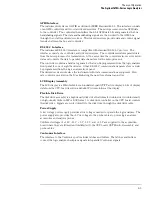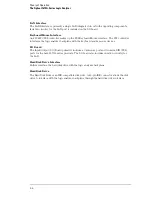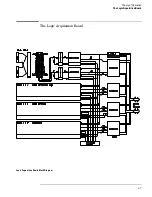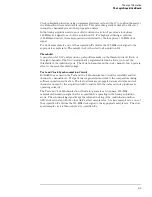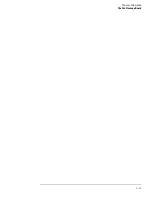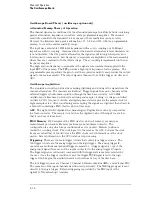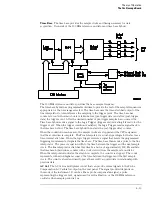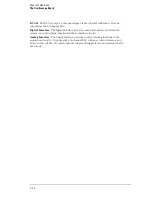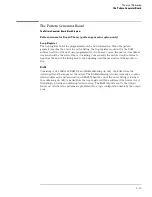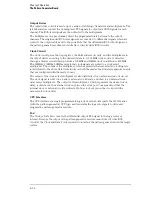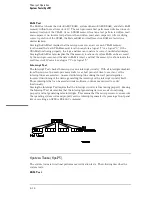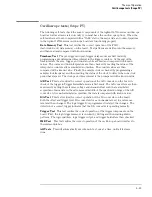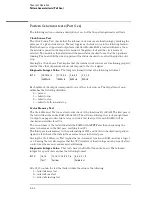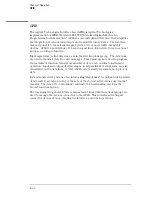
The ROM test performs several checksum tests on various read only memory elements,
including the system ROM as well as the various software modules present in flash ROM.
Passing the ROM test implies that the microprocessor can access each ROM memory address
and that each ROM segment provides checksums that match previously calculated values.
RAM Test
The RAM test performs a write/read operation in each memory location in system dynamic
RAM (DRAM). The video RAM in the display subsystem and the acquisition RAM in the data
acquisition subsystem are not tested as part of the RAM test and are tested elsewhere. At
each DRAM memory location, the code that resides at that location is stored in a
microprocessor register. A test pattern is then stored at the memory location, read, and
compared. An inverse test pattern is then stored, read, and compared. The original code is
then restored to the memory location. This continues until all DRAM memory locations have
been tested. The static RAM in the real time clock chip is also tested in a similar fashion.
Passing the RAM test implies that all RAM memory locations can be accessed by the
microprocessor and that each memory location can store a logical "1" or a logical "0."
GPIB Test
The GPIB test performs a write/read operation to each of the registers of the GPIB IC. A test
pattern is written to each register in the GPIB IC. The pattern is then read and compared
with a known value.
Passing the GPIB test implies that the read/write registers in the GPIB IC can store a logical
"1" or a logical "0," and that the GPIB IC is functioning properly. Incoming and outgoing GPIB
information will not be corrupted by the GPIB IC.
RS-232-C Test
This test checks the basic interface functions of the RS-232-C port. Both internal and
external portions of the port circuitry are tested. In order for the RS-232-C test to pass, the
RS-232-C loopback connector must be installed on the RS-232-C connector.
PS2 Test
The PS2 test exercises the PS2 interface between the logic analyzer and external keyboard, if
an external keyboard is connected. First, a read/write operation is performed to each of the
registers of the PS2 IC. A test pattern is written to each memory location, read, and
compared with a known value. Second, if an external keyboard is connected to the PS2 port,
the keyboard controller that resides in the keyboard is polled by the microprocessor. A test
pattern is sent to the keyboard controller and returned to the microprocessor by the keyboard
controller. The test pattern is then compared with a known value.
Passing the PS2 test implies that the read/write registers in the PS2 IC can store a logical "1"
or a logical "0," and that the PS2 IC is functioning properly. Also, passing the PS2 test implies
that the PS2 pathway to the external keyboard is functioning and that the keyboard controller
can communicate with the microprocessor in the logic analyzer. Incoming PS2 information
from the external keyboard will not be corrupted by the pathway between the keyboard
controller and microprocessor.
Disk Test
The disk test verifies the operation of both the flexible disk drive and hard disk drive.
For the flexible disk drive, the disk test exercises the disk controller circuitry by performing a
write/read on a disk. Either a LIF-formatted disk with 20 sectors available space or
DOS-formatted disk with 5K available space is required and should be inserted in the disk
drive. When the disk test is executed the disk is first checked sector by sector to find any bad
Theory of Operation
System Tests (SysPV)
8–19
Summary of Contents for 1670G Series
Page 20: ...1 12...
Page 116: ...Testing Performance Performance Test Record pattern generator 3 92...
Page 126: ...Calibrating and Adjusting To test the CAL OUTPUT ports 4 10...
Page 166: ...Exploded View of the Agilent 1670G series logic analyzer Replacing Assemblies 6 4...
Page 201: ...Theory of Operation The Oscilloscope Board 8 11...

